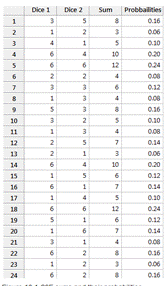
Concept explainers
(a)
To list:the possible sums that result from rolling two six-sided dice.
(a)
Answer to Problem 23E
The possible sums are: 2,3,4,5,6,7,8,9,10,11,12 .
Explanation of Solution
Given:
| A | B | C | |
| 1 | First die | Second die | sum |
| 2 | 4 | 6 | 10 |
| 3 | 3 | 5 | 9 |
| 4 | 1 | 8 | 7 |
Calculation:
A probability experiment is an action, or trial that has varying results. The possible result of a probability experiment is known as outcomes. The set of all possible outcomes is called samplespace. The
(1,1),(1,2),(1,3),(1,4),(1,5),(1,6)
(2,1),(2,2),(2,3),(2,4),(2,5),(2,6)
(3,1),(3,2),(3,3),(3,4),(3,5),(3,6)
(4,1),(4,2),(4,3),(4,4),(4,5),(4,6)
(5,1),(5,2),(5,3),(5,4),(5,5),(5,6)
(6,1),(6,2),(6,3),(6,4),(6,5),(6,6)
Studying the outcomes, the possible sums that result from rolling two six sided dice are as follows:
2,3,4,5,6,7,8,9,10,11,12
Therefore, the answers are: 2,3,4,5,6,7,8,9,10,11,12 .
Conclusion:
Therefore, the possible sums are: 2,3,4,5,6,7,8,9,10,11,12 .
(b)
To find: the theoretical probability of rolling each sum.
(b)
Answer to Problem 23E
| Sum | probabilities | sum | probabilities |
| 2 | 0.028 | 8 | 0.1389 |
| 3 | 0.056 | 9 | 0.1111 |
| 4 | 0.0833 | 10 | 0.0833 |
| 5 | 0.1111 | 11 | 0.0556 |
| 6 | 0.1389 | 12 | 0.0278 |
| 7 | 0.1667 |
Explanation of Solution
Calculation:
There are 36 outcomes and outcomes for a specified event are called favorable outcomes. Whenall outcomes are equally likely, the theoretical probability is described as the ratio of number of favorable outcomes to total number of outcomes. Therefore, the required probability is asfollows:
Equivalently, compute the remaining probabilities. The following tale illustrates the probabilities of remaining sums.
| Sum | probabilities | sum | probabilities |
| 2 | 0.028 | 8 | 0.1389 |
| 3 | 0.056 | 9 | 0.1111 |
| 4 | 0.0833 | 10 | 0.0833 |
| 5 | 0.1111 | 11 | 0.0556 |
| 6 | 0.1389 | 12 | 0.0278 |
| 7 | 0.1667 |
Table illustrates the probabilities of rolling each sum in the second column.
Conclusion:
Therefore, the table illustrates the probabilities of rolling each sum in the second column.
| Sum | probabilities | sum | probabilities |
| 2 | 0.028 | 8 | 0.1389 |
| 3 | 0.056 | 9 | 0.1111 |
| 4 | 0.0833 | 10 | 0.0833 |
| 5 | 0.1111 | 11 | 0.0556 |
| 6 | 0.1389 | 12 | 0.0278 |
| 7 | 0.1667 |
(c)
To compare: the experimental probabilities of rolling each sum with the theoretical probabilities.
(c)
Answer to Problem 23E
The results show that both are close but not exactly equal.
Explanation of Solution
Calculation:
The experimental probability is the ratio of number of successes to number of trials. Userandom number generator to generate 50 numbers each ranging from 1 to 6 for two dices.
Calculate the sum. Then compute the experimental probability of each sum.
The following screen shot illustrates the probabilities of sums for first 24 trials.

Compare both experimental and theoretical probabilities.
The results show that both are closebut not exactly equal.
Conclusion:
The results show that both are close but not exactly equal.
Chapter 10 Solutions
Big Ideas Math A Bridge To Success Algebra 2: Student Edition 2015
- 5) You are purchasing a game for $30. You have a 5% off coupon and sales tax is 5%. What will your final price be? Does it matter if you take off the coupon first or add in the tax first? 6) You have ten coupons that allow you to take 10% off the sales price of a jacket, and for some strange reason, the store is going to allow you to use all ten coupons! Does this mean you get the jacket for free? Let's really think about what would happen at the checkout. First, the teller would scan the price tag on the jacket, and the computer would show the price is $100. After the teller scans the first coupon, the computer will take 10% off of $100, and show the price is $90. (Right? Think about why this is.) Then after the teller scans the second coupon, the computer will take 10% off of $90. (a) Continue this reasoning to fill in the table below showing the price of the jacket (y) after you apply x coupons. (b) Make a graph showing the price of the jacket from x = 0 to x = 10 coupons applied.…arrow_forward(a) (b) (c) (d) de unique? Answer the following questions related to the linear system x + y + z = 2 x-y+z=0 2x + y 2 3 rewrite the linear system into the matrix-vector form A = 5 Fuse elementary row operation to solve this linear system. Is the solution use elementary row operation to find the inverse of A and then solve the linear system. Verify the solution is the same as (b). give the null space of matrix A and find the dimension of null space. give the column space of matrix A and find the dimension of the column space of A (Hint: use Rank-Nullity Theorem).arrow_forwardplease explain in a clear wayarrow_forward
- Solve questions by Course Name Ordinary Differential Equationsarrow_forwardDetermine whether it's true or false and the reasoning is neededarrow_forward1. (20 pts) Determine whether the following statements are true (T) or false (F)? (A reasoning is required.) (1) Let V be the set of all ordered pairs of real numbers. Consider the following addition and scalar multiplication operations on u = u= (u1, u2) and v = (v1, v2): u + v = (U₁ + V₁, U₂ + v₂), ku = (ku₁, u₂). Is V a vector space under the above operations? U2 (2) The set Mmxn of all m×n matrices with the usual operations of addition and scalar multiplication is a vector space. α (3) The dimension of the vector space of all matrices A = [a b] in R2×2 with a+d=0 is 4. (4) The coordinate vector of p(x) = 2-x+x² in P3 relative to the basis S = {1, 1+x, x + x2} is [4 -2 1]. (5) If a 6×4 matrix A has a rank 3, then the dimension of N(A) is 3.arrow_forward
- 5. (20%) The linear transformation L: P3 → P2 defined by L(f(x)) = f'(x)+ f(0). (a) Find the representing matrix A of L with respect to the ordered basis {x2, x, 1} for P3, and the ordered basis {2,1 - x} for P2. (b) Find the coordinates of the f(x) = 2x² +2 in P3 with respect to the ordered basis {x2,-x, 1}, and find the coordinates of L(f(x)) with respect to the ordered basis {2,1-x}arrow_forwardFor the spinner below, assume that the pointer can never lie on a borderline. Find the following probabilities. (enter the probabilities as fractions)arrow_forwardQuestions 1. Identify and describe potential bias in the study. 2. Identify and describe the way in which the selected participants may or may not represent the population as a whole. 3. Identify and describe the possible problems with the end results since the majority will be from females rather than an even split. 4. Identify and describe the possible problems with identifying females as possibly more vulnerable based on the data collected. 5. Identify a possible null hypothesis and problems in how the study might address this null hypothesis. 6. Identify one possible method of improving the study design and describe how it would improve the validity of the conclusions. 7. Identify a second possible method of improving the study design and describe how it would improve the validity of the conclusions.arrow_forward
- The Course Name Real Analysis please Solve questions by Real Analysisarrow_forwardpart 3 of the question is: A power outage occurs 6 min after the ride started. Passengers must wait for their cage to be manually cranked into the lowest position in order to exit the ride. Sine function model: where h is the height of the last passenger above the ground measured in feet and t is the time of operation of the ride in minutes. What is the height of the last passenger at the moment of the power outage? Verify your answer by evaluating the sine function model. Will the last passenger to board the ride need to wait in order to exit the ride? Explain.arrow_forward2. The duration of the ride is 15 min. (a) How many times does the last passenger who boarded the ride make a complete loop on the Ferris wheel? (b) What is the position of that passenger when the ride ends?arrow_forward
 Algebra and Trigonometry (6th Edition)AlgebraISBN:9780134463216Author:Robert F. BlitzerPublisher:PEARSON
Algebra and Trigonometry (6th Edition)AlgebraISBN:9780134463216Author:Robert F. BlitzerPublisher:PEARSON Contemporary Abstract AlgebraAlgebraISBN:9781305657960Author:Joseph GallianPublisher:Cengage Learning
Contemporary Abstract AlgebraAlgebraISBN:9781305657960Author:Joseph GallianPublisher:Cengage Learning Linear Algebra: A Modern IntroductionAlgebraISBN:9781285463247Author:David PoolePublisher:Cengage Learning
Linear Algebra: A Modern IntroductionAlgebraISBN:9781285463247Author:David PoolePublisher:Cengage Learning Algebra And Trigonometry (11th Edition)AlgebraISBN:9780135163078Author:Michael SullivanPublisher:PEARSON
Algebra And Trigonometry (11th Edition)AlgebraISBN:9780135163078Author:Michael SullivanPublisher:PEARSON Introduction to Linear Algebra, Fifth EditionAlgebraISBN:9780980232776Author:Gilbert StrangPublisher:Wellesley-Cambridge Press
Introduction to Linear Algebra, Fifth EditionAlgebraISBN:9780980232776Author:Gilbert StrangPublisher:Wellesley-Cambridge Press College Algebra (Collegiate Math)AlgebraISBN:9780077836344Author:Julie Miller, Donna GerkenPublisher:McGraw-Hill Education
College Algebra (Collegiate Math)AlgebraISBN:9780077836344Author:Julie Miller, Donna GerkenPublisher:McGraw-Hill Education





